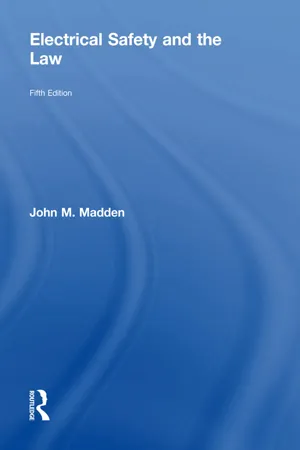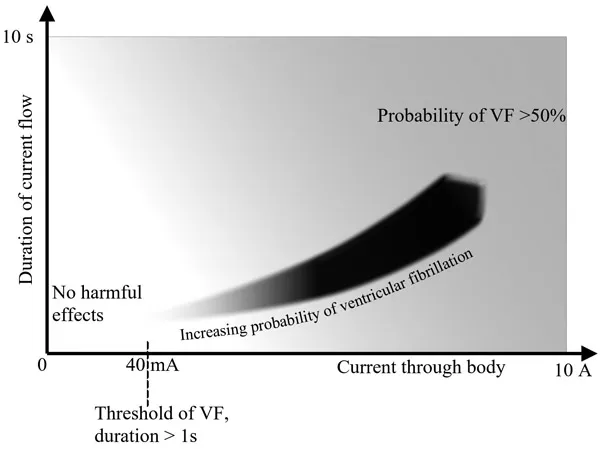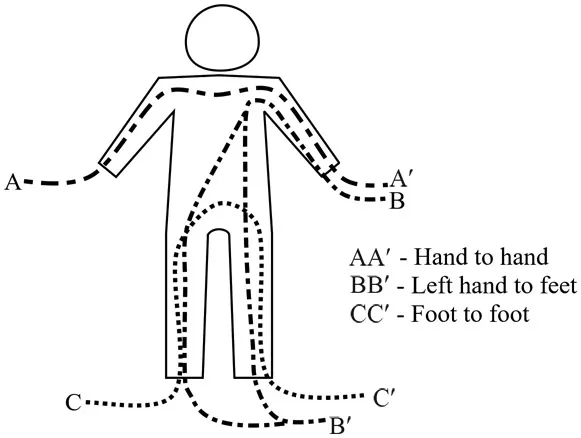![]()
1
The hazards and risks from electricity
Introduction
Electricity is such an important part of our everyday lives that it is difficult to countenance how we would manage to live without it. However, despite its obvious benefits as a source of energy and power, electricity is also a hazard in so far as it is capable of causing injury, including fatal injury.
Electricity is just one of the many types of hazards that we experience in our daily lives, other examples are chemicals, noise, machinery, falling from height, stress, impact with moving vehicles, using a keyboard and so on. Although these hazards do not routinely cause us harm, they have the potential to do so. We therefore need to be concerned not just with the existence of a hazard but also the likelihood, or probability, of it causing personal injury or ill health. The probability of a particular hazard causing harm is the concept of risk, which relates the severity of the harm to the probability of it occurring. The purpose of the legislation and protective measures described in this book is to reduce the risk of injury or death from electricity to a level that we find acceptable, the legal term for which in the UK is ‘so far as is reasonably practicable’, a concept which is explained further in Chapter 4.
As a starting point in considering electrical risks, it is helpful to have a good understanding of the types of injury that electricity can cause. This chapter explains the injuries so that later discussions on the legislative framework and precautionary techniques can be put into context.
Electricity can cause the following types of injuries:
- electric shock;
- burns caused by electric current passing through the body;
- burns caused by electric arcing, commonly known as ‘flashover’ or ‘arc flash’;
- the effects of fire that has an electrical origin;
- the effects of an explosion that has an electrical source of ignition; and
- the physiological effects of electromagnetic radiation.
The chapter is not concerned with other types of injuries, such as crushing and shearing injuries, that may occur as a consequence of, for example, a machine operating aberrantly because of a fault in its electrical control system. However, the topic of the safety integrity of electrotechnical machinery control systems is considered in Chapter 17.
Although each of the injury mechanisms is considered separately, in reality they often occur together. For example, current passing through the body causes an electric shock, but current passing through tissues also causes the tissues to heat up, often to the point at which burn injuries occur. So shock and burn injuries are frequently, but by no means always, experienced together.
Electric shock
If electric current of sufficient magnitude and duration passes through the body, it may disrupt the nervous system, causing the painful sensation of electric shock. The effects of such a shock can range from being mildly unpleasant to being fatal, with death most commonly resulting from cardiac arrest or ventricular fibrillation of the heart, a condition in which the heart’s ventricular muscles quiver in a way that prevents blood being pumped around the body. Incidents are most frequently caused by making simultaneous contact with a live conductor and a conductor that is earthed, although some incidents occur when contact is made with two conductors energised at different potentials, neither of which is at earth potential.
Shock injuries are almost always associated with alternating current (a.c.), while direct current (d.c.) electric shock injuries are rare. This is partly because a.c. systems dominate in the workplace and in the home, but also because the excitation effects of direct current on the nervous system are less severe than those of the equivalent magnitude of alternating current. For this reason, only the effects of current at the most common power frequencies of 50 Hz and 60 Hz will be considered in detail, where Hz or Hertz is the SI unit of frequency measured in cycles per second. Broadly, 50 Hz is the power frequency in Europe, Africa, Russia, China, Australia and New Zealand, whereas 60 Hz is used on the North and South American continents, and in countries such as South Korea, the Philippines, Taiwan and Saudi Arabia.
The seriousness of the physiological effects of current passing through the body is directly related to the current’s magnitude and duration and to the path that the current takes through the body. The magnitude of the current is related to the voltage across the body (the touch voltage) and to the body’s impedance according to Ohm’s law, which simply states that the current, I amperes, flowing through an impedance of X Ω (ohms) is derived by dividing the voltage, E Volts, across the impedance by the value of that impedance such that I = E/X amperes. Impedance, rather than pure resistance, must be used because the body contains capacitive reactance at power frequencies.
There has been some research carried out over the years to characterise the effects of current flowing through the body. Most of this has been carried out on animals and human cadavers, although some has been carried out on a very limited number of human volunteers. The small number of volunteers is, perhaps, quite understandable. Some general conclusions can be drawn from the published information, much of which is very usefully summarised in an International Electrotechnical Commission (IEC) standard published in the UK by the British Standards Institution (BSI) as British Standard DD IEC/TS 60479–1:2005, Effects of current on human beings and livestock. General aspects.
Body impedance
At power frequencies (50 Hz and 60 Hz), the body’s impedance comprises resistance and capacitive reactance. The capacitance is concentrated in the skin, whilst the resistance is associated with both the skin and the internal path through the body; however, the largest contribution of resistance is the skin barrier. The instantaneous value of impedance for any individual depends on a wide range of factors, not least of which is the applied voltage. In general terms, the higher the voltage, the lower will be the total body impedance, with the asymptotic low value being in the order of 750 Ω for 50% of the population for touch voltages greater than 1000 V and for a current path from hand to feet. The impedance falls as the voltage increases, because at higher voltages the skin barrier breaks down. At 230 V, which is the voltage at which most electric shock accidents occur, or 120 V in countries such as the United States and Canada, the impedance ranges between 1000 Ω and 2500 Ω for most of the population, again for a hand-to-feet path.
The path that the current takes through the body has a significant effect on the impedance. For example, the impedance for a hand-to-chest path will be in the order of 50% of the impedance for a hand-to-foot path. If the impedance is low, the current will be equivalently high for the same touch voltage.
Other factors affect the impedance. For example, the impedance will be lowered if a sharp object forming part of the circuit, such as a strand of wire, punctures the skin. It will also be lowered by increasing the area of contact, and by wetting the skin surface. Some of the experiments with volunteers used cylindrical metal electrodes, about 100 mm long by 80 mm diameter, held in each hand. It was found that wetting the hands with tap water lowered the impedance a little on the value measured when the hands were dry, but wetting with a 3% salt solution halved the impedance value. Other factors such as age, gender and state of health also affect the impedance.
Effects
The physiological effects of current passing through the body from hand to feet are summarised in Table 1.1, derived and adapted from information in IEC/TS 60479–1. The figures are a rough yardstick and apply to an average person in good health and for a sustained shock exceeding a duration in the order of 1 second. For a shock duration less than 1 second, greater currents can be tolerated without such adverse reactions, particularly concerning the probability of ventricular fibrillation.
Table 1.1 The effect of passing alternating current (50/60 Hz) through the body from hand to feet | Current in milliAmps (mA) | Physiological effect |
0.5–2 | Threshold of perception |
2–10 | Painful sensation, increasing with current. Muscular contraction may occur, leading to being ‘thrown off’. |
10–25 | Threshold of ‘let go’, meaning that gripped electrodes cannot be released. Cramplike muscular contractions. May have difficulty breathing leading to danger of asphyxiation from respiratory muscular contraction. |
25–80 | Severe muscular contraction, sometimes severe enough to cause bone dislocation and fracture. Increased likelihood of respiratory failure. Increased blood pressure. Increasing likelihood of ventricular fibrillation (uncoordinated contractions of the heart muscles so that it ceases to pump effectively) as current exceeds about 40 mA. Possible cardiac arrest. |
Over 80 | Burns at point of contact and in internal tissues. Increasing probability of death from ventricular fibrillation, cardiac arrest or other consequential injuries. |
The most common electric shock effect when a conductor energised at mains voltages is touched is for the consequential muscular contraction to result in the individual being ‘thrown off’ the conductor. Whereas a painful lesson may have been learned, there are rarely any significant physiological effects unless the physical reaction leads to injuries such as impact injuries or a fall from a height should, for example, the individual be working on a ladder at the instant the shock is experienced. However, if the individual were to be gripping a conductor when it is energised, and if the current flowing though the hand/arm exceeds the threshold of let-go of about 10 mA, rather than being thrown off the conductor, it is possible for the hand to grip onto the conductor and for the muscular reaction to prevent release. The current may increase in magnitude as the palm of the hand becomes moist from sweat. If the current flows across the heart muscle and exceeds about 40 mA, there is the potential for ventricular fibrillation to occur.
The heart is vulnerable to ventricular fibrillation when shock current flows during the first part of the ‘T’ wave in the cardiac cycle, which is approximately 10 to 20% of the cycle. The shock stimulus produces extra systoles (heart beats), and if it embraces the vulnerable period, and particularly if it persists over several cardiac cycles, the risk of ventricular fibrillation is increased. This explains why the probability of ventricular fibrillation is greater for longer durations of current flow. For example, it has been found from experiments with dogs, and allowing for the difference in weight, that humans should be able to tolerate 650 mA for 10 to 80 milliseconds and 500 mA for 80 to 100 milliseconds without much risk of ventricular fibrillation. However for longer durations, above 1 second, these current magnitudes cannot be tolerated, and the effects tend to be as described in Table 1.1.
It is this type of experimental data, together with data derived from accidents, that explains why residual current devices (RCDs) with a residual operating current (IΔN) of 30 mA provided for personal protection are rated to trip within 40 milliseconds for a residual current of 150 mA (5 × IΔN). RCDs do not restrict the level of current flowing, but they do restrict the duration of the current to a nominally safe level. This topic is covered further in Chapter 3.
The overall relationship between current, duration and probability of ventricular fibrillation is illustrated in Figure 1.1, which is derived and adapted from information presented in DD IEC/TS 60479–1:2005, to which the interested reader who may require more detailed information is referred.
It should also be noted that the probability of ventricular fibrillation depends upon the path that the current takes through the body. For example, a shock from hand to feet is more dangerous than a shock of the same magnitude from hand to hand. DD IEC/TS 60479–1:2005 defines a heart-current factor that can be used to determine the different effects for different paths through the body. The factor is defined as the ratio of the electric field strength in the heart, for a given current path, to the electric field strength in the heart for a current of equal magnitude flowing from the left hand to both feet.
Refer to Figure 1.2, and assume that the current flowing in path BB' from left hand to both feet is 100 mA and its duration creates a 25% probability of ventricular fibrillation in a particular individual. The heart-current factor for path AA', hand to hand, is 0.4, meaning that the current would need to be 250 mA to create the same probability of ventricular fibrillation. Similarly, the heart-current factor for path CC', between the feet, is 0.04, meaning that 2500 mA would need to flow through that path to create the same probability of ventricular fibrillation.
Figure 1.1 Summary diagram of relationship between current magnitude and duration and probability of ventricular fibrillation (VF)
Figure 1.2 The effect of the heart-current factor
Although there is a tendency to concentrate on cardiac effects of electric shock, current flow can also lead to respiratory paralysis. Immobilisation of the respiratory muscles, with the possibility of asphyxial death, can occur if the current is in the order of 18 to 30 milliamps for a limb to limb path (Electrical Injuries; Engineering, medical and legal aspects; Nabours, Fish and Hill; Lawyers & Judges Publishing Company; 2000).
The seriousness of electric shock injuries is related to the magnitude of the shock current, but the voltage also needs to be considered since it is this parameter that most people will be aware of. There is no doubt that sustained shocks at the normal mains voltage of 230 V can be fatal. It is generally accepted that, in dry conditions, 50 V a.c. is a voltage that for most healthy people will not lead to fatal injuries, although a margin of safety is needed, as reflected in the value of 25 V used for the Safety Extra-Low Voltage (SELV) systems described in Chapter 3; the term ‘low voltage’ refers to a voltage lower than 1000 V a.c. or 1500 V d.c., with higher voltages being classed ‘high voltage’. The risk of serious injury increases as the voltage increases above 50 V, although it is not a step change at that level. Welders, for example, frequently touch their live welding electrodes which have an open circuit voltage up to about 80 V; whereas they will experience minor shocks leading to muscular contraction, the incidence of serious electric shock injuries at that voltage is very low.
Unusual waveforms
The discussion so far has concentrated on a.c. sine or cosine waveforms at the very common power frequencies of 50 Hz and 60 Hz and at the public supply voltage of 230 V single phase. This is reasonable because by far the large majority of electrical accidents occur on systems energised at those voltages. However, not all electrical systems operate at power frequencies, so some assessment of the risk of injury needs to be made for them.
A good example is electric fence energisers, which are commonly used to power electric fences for stock control and, increasingly, for security. These energisers typically transmit pulses onto the connected fence wire with peak voltages in the order of 10,000 V, with a duration of 1 millisecond, and a pulse ...


